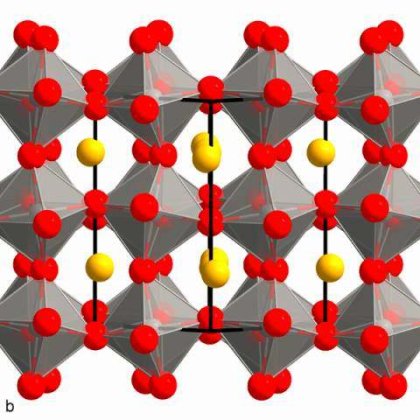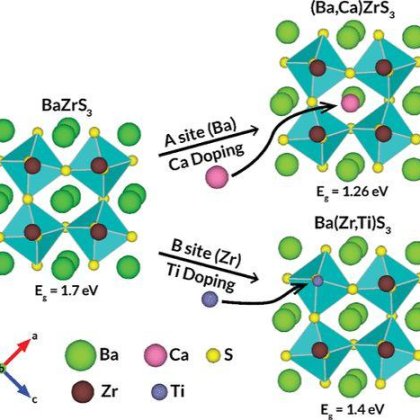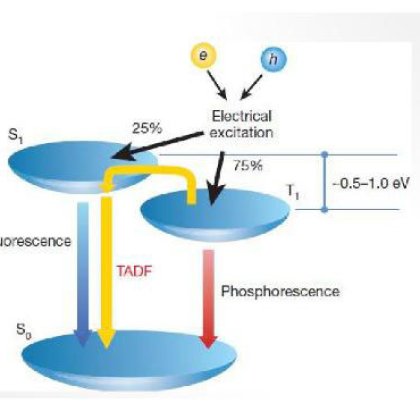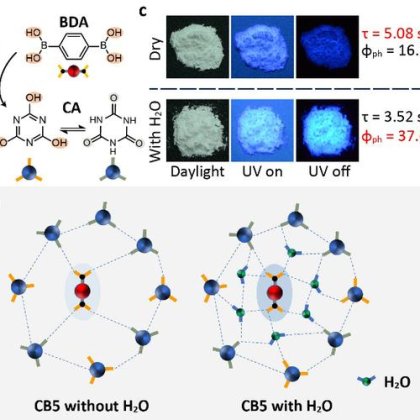| Notes | XRD spectra, user instruction for enquiring |
| Store | 25℃ under N2 atmosphere |
| Packaging | 3 g, or as required in glass bottle |
| Solubility | Soluble in DMSO,DMF et al |
| Appearance | Brown black solid |
| Linear Formula | CH6Br2INPb |
| CAS Number | 1472068-58-8 |
| Stock Name | MAPbBr2I |
| Name(EN) | MAPbBr2I |
| Synonym | CH3NH3PbBr2I/MAPbBr2I |
| Purity | 99% |
| Mol. Weight | 525.98 |
Optoelectronic Evolution in Halogen-Doped Organic–Inorganic Halide Perovskites: A First-Principles Analysis
Xiao, Cheng-Liang; Liu, Sicheng; Liu, Xiao-Yan; Li, Yi-Ning; Zhang, Peng [Molecules, 2023, vol. 28, # 21, art. no. 7341]
Abstract
Cl, Br, and I are elements in the halogen family, and are often used as dopants in semiconductors. When employed as dopants, these halogens can significantly modify the optoelectronic properties of materials. From the perspective of halogen doping, we have successfully achieved the stabilization of crystal structures in CH3NH3PbX3, CH3NH3PbI3−xClx, CH3NH3PbI3−xBrx, and CH3NH3PbBr3−xClx, which are organic–inorganic hybrid perovskites. Utilizing first-principles density functional theory calculations with the CASTEP module, we investigated the optoelectronic properties of these structures by simulations. According to the calculations, a smaller difference in electronegativity between different halogens in doped structures can result in smoother energy bands, especially in CH3NH3PbI3−xBrx and CH3NH3PbBr3−xClx. The PDOS of the Cl-3p orbitals undergoes a shift along the energy axis as a result of variances in electronegativity levels. The optoelectronic performance, carrier mobility, and structural stability of the CH3NH3PbBr3−xClx system are superior to other systems like CH3NH3PbX3. Among many materials considered, CH3NH3PbBr2Cl exhibits higher carrier mobility and a relatively narrower bandgap, making it a more suitable material for the absorption layer in solar cells. This study provides valuable insights into the methodology employed for the selection of specific types, quantities, and positions of halogens for further research on halogen doping.
Anomalous Structural Evolution and Glassy Lattice in Mixed-Halide Hybrid Perovskites
Shahrokhi, Shamim; Dubajic, Milos; Dai, Zhi-Zhan; Bhattacharyya, Saroj; Mole, Richard A.; Rule, Kirrily C.; Bhadbhade, Mohan; (…) Cazorla, Claudio; Wu, Tom [Small, 2022, vol. 18, # 21, art. no. 2200847]Abstract
Hybrid halide perovskites have emerged as highly promising photovoltaic materials because of their exceptional optoelectronic properties, which are often optimized via compositional engineering like mixing halides. It is well established that hybrid perovskites undergo a series of structural phase transitions as temperature varies. In this work, the authors find that phase transitions are substantially suppressed in mixed-halide hybrid perovskite single crystals of MAPbI3-xBrx (MA = CH3NH3+ and x = 1 or 2) using a complementary suite of diffraction and spectroscopic techniques. Furthermore, as a general behavior, multiple crystallographic phases coexist in mixed-halide perovskites over a wide temperature range, and a slightly distorted monoclinic phase, hitherto unreported for hybrid perovskites, is dominant at temperatures above 100 K. The anomalous structural evolution is correlated with the glassy behavior of organic cations and optical phonons in mixed-halide perovskites. This work demonstrates the complex interplay between composition engineering and lattice dynamics in hybrid perovskites, shedding new light on their unique properties.
Room-Temperature Molten Salt for Facile Fabrication of Efficient and Stable Perovskite Solar Cells in Ambient Air
Chao, Lingfeng; Xia, Yingdong; Li, Bixin; Xing, Guichuan; Chen, Yonghua; Huang, Wei [Chem, 2019, vol. 5, # 4, p. 995 - 1006]Abstract
Organic-inorganic hybrid perovskites have recently attracted extensive attention for their potential uses in photovoltaics. However, solvent-handling issues and toxicology concerns represent a major challenge in solution-processed perovskite thin films. Here, we demonstrate that an environmentally- and industrially friendly room-temperature molten salt (RTMS), methylammonium acetate (MAAc), can produce high-quality perovskite films in ambient air, leading to the development of perovskite solar cells (PSCs) with 20% efficiency and stability for more than 1,000 h. MAAc is a universal solvent for all common perovskite-based salts and may open up the potential of using RTMS solvent for facile fabrication of PSCs. Moreover, this work represents a new direction in the development of efficient and stable PSCs and other optoelectronic devices. A solvent is vital to the control of crystallization and crystal growth in state-of-the-art solution-processed hybrid organic-inorganic perovskites. We demonstrate an alternative environmentally friendly room-temperature molten salt, methylammonium acetate (MAAc), as a solvent characterized by high viscosity, negligible vapor pressure, and nonhazardous nature, which can be used to produce highly efficient perovskite solar cells (PSCs) in ambient air. The resulting PSCs exhibited excellent stability under light and dark conditions. Here, we report an alternative environmentally friendly room-temperature molten salt, methylammonium acetate (MAAc), as a novel solvent for facile fabrication of perovskite solar cells (PSCs) in ambient air. MAAc possesses excellent chemical properties along with high viscosity, negligible vapor pressure, and a nonhazardous nature. Complete solubility of both methylammonium and lead salts by hydrogen bonds in MAAc was observed. Dense and pinhole-free perovskite films with high reproducibility can be readily prepared by a simple one-step method without an anti-solvent even under a relative humidity of over 80%. Under optimized processing conditions, we achieved an average power conversion efficiency of 18.42% and a maximum efficiency of 20.05% in CH3NH3PbI3-based planar heterojunction structure. In addition, devices without encapsulation remained above 93% of their original efficiency for more than 1,000 h in ambient air. These findings may open up the possibility of developing a new approach for further improving PSC performance with higher reproducibility and reliability in ambient atmosphere.
| Characteristic 1 | I |
| Characteristic 2 | Pb |













